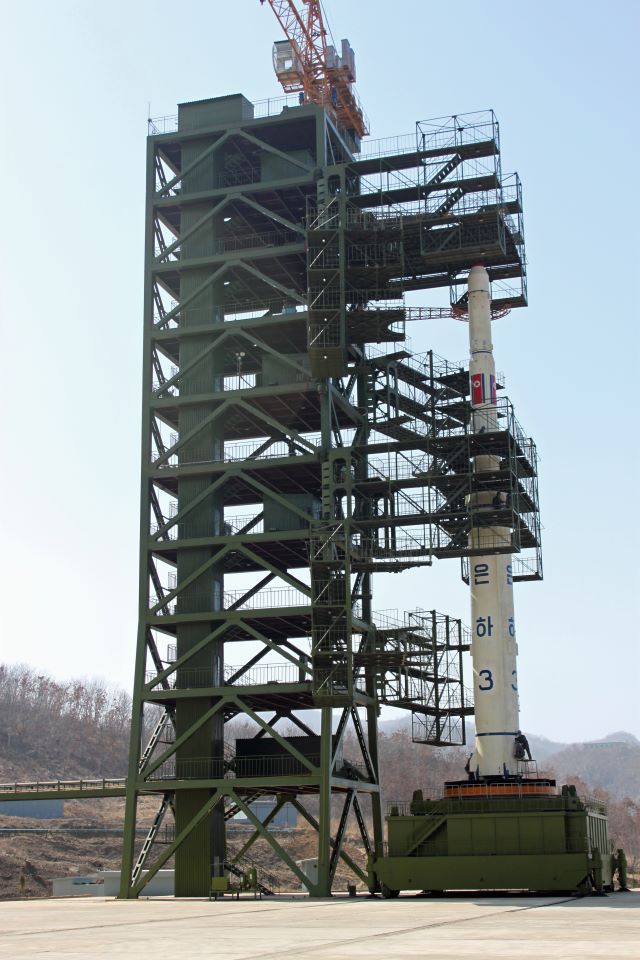Korean Committee Of Space Technology on:
[Wikipedia]
[Google]
[Amazon]
The Korean Committee of Space Technology (KCST; ,
 The KCST operated the Tonghae Satellite Launching Ground and Sohae Satellite Launching Station rocket launching sites, Paektusan-1 and
The KCST operated the Tonghae Satellite Launching Ground and Sohae Satellite Launching Station rocket launching sites, Paektusan-1 and
Hanja
Hanja (; ), alternatively spelled Hancha, are Chinese characters used to write the Korean language. After characters were introduced to Korea to write Literary Chinese, they were adapted to write Korean as early as the Gojoseon period.
() ...
: 朝鮮宇宙空間技術委員會) was the agency of the government
A government is the system or group of people governing an organized community, generally a State (polity), state.
In the case of its broad associative definition, government normally consists of legislature, executive (government), execu ...
of the Democratic People's Republic of Korea
North Korea, officially the Democratic People's Republic of Korea (DPRK), is a country in East Asia. It constitutes the northern half of the Korea, Korean Peninsula and borders China and Russia to the north at the Yalu River, Yalu (Amnok) an ...
(North Korea) responsible for the country's space program
A space program is an organized effort by a government or a company with a goal related to outer space.
Lists of space programs include:
* List of government space agencies
* List of private spaceflight companies
* List of human spaceflight prog ...
. The agency was terminated and succeeded by the National Aerospace Development Administration in 2013 after the Law on Space Development was passed in the 7th session of the 12th Supreme People's Assembly.
History
Very little information on it is publicly available. It is known to have been founded sometime in the 1980s, and most likely is connected to the Artillery Guidance Bureau of theKorean People's Army
The Korean People's Army (KPA; ) encompasses the combined military forces of North Korea and the armed wing of the Workers' Party of Korea (WPK). The KPA consists of five branches: the Korean People's Army Ground Force, Ground Force, the Ko ...
.
Operations
The KCST was responsible for all operations concerningspace exploration
Space exploration is the process of utilizing astronomy and space technology to investigate outer space. While the exploration of space is currently carried out mainly by astronomers with telescopes, its physical exploration is conducted bo ...
and construction of satellites. On 12 March 2009, North Korea signed the Outer Space Treaty
The Outer Space Treaty, formally the Treaty on Principles Governing the Activities of States in the Exploration and Use of Outer Space, including the Moon and Other Celestial Bodies, is a Multilateralism, multilateral treaty that forms the bas ...
and the Registration Convention
The Convention on Registration of Objects Launched into Outer Space (commonly known as the Registration Convention) was adopted by the United Nations General Assembly in 1974 and went into force in 1976. As of February 2022, it has been ratified ...
, after a previous declaration of preparations for a new satellite launch.
Facilities
 The KCST operated the Tonghae Satellite Launching Ground and Sohae Satellite Launching Station rocket launching sites, Paektusan-1 and
The KCST operated the Tonghae Satellite Launching Ground and Sohae Satellite Launching Station rocket launching sites, Paektusan-1 and Unha
The Unha (, "Galaxy") is a North Korean expendable launch system, expendable launch vehicle, carrier rocket, which partially utilizes the same delivery system as the Taepodong-2 orbital launch system.
History
North Korea's first orbital space ...
launchers, Kwangmyŏngsŏng satellites.
South Korea and the United States accused North Korea of using these facilities and the rockets as a cover for a military ballistic missile testing program.
* Sohae Satellite Launching Station built from the 2000s to 2010s with a launch pad completed in 2011.
* Tonghae Satellite Launching Ground built from the 2000s to 2010s with a launch pad completed in 2011.
Projects
The DPRK twice announced that it had launched satellites: Kwangmyŏngsŏng-1 on 31 August 1998 and Kwangmyŏngsŏng-2 on 5 April 2009. The US and South Korea predicted that the launches would in actuality be military ballistic missile tests, but later confirmed that they had followed orbital launch trajectories. In 2009, the DPRK announced more ambitious future space projects including its own crewed space flights and development of a crewed partially reusable launch vehicle. Kwangmyŏngsŏng-3 was launched on 13 April 2012 and ended in failure shortly after launch. A follow-up attempt the following December, Kwangmyŏngsŏng-3 Unit 2 entered polar orbit as confirmed by various countries.Launch history
This is a list of satellites launched.See also
* North Korean space program *List of government space agencies
Government space agencies, established by the governments of countries and regional agencies (groupings of countries) are established as a means for advocating for engaging in activities related to outer space, exploitation of space systems, ...
* List of space agencies
Government space agencies, established by the governments of countries and regional agencies (groupings of countries) are established as a means for advocating for engaging in activities related to outer space, exploitation of space systems, ...
* National Aerospace Development Administration
References
{{DEFAULTSORT:Korean Committee Of Space Technology Space agencies Space program of North Korea